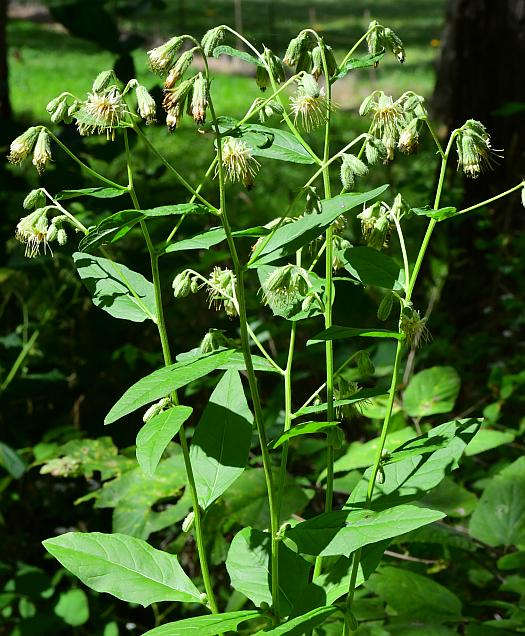Nabalus crepidineus (Michx.) DC.
Great White Lettuce

Native
CC = 9
CW = 3
MOC = 17
© SRTurner
Nabalus crepidineus (Michx.) DC.Great White Lettuce | |
 |
Native CC = 9 CW = 3 MOC = 17 |
© SRTurner |
|
Family - Asteraceae/Cichorieae Habit - Perennial forb, usually with somewhat tuberous-thickened rootstocks, colonial, often producing offsets. Latex white. Stems - Ascending to erect, to 2.5 m, relatively stout, glabrous or sparsely to moderately pubescent with short, curled hairs toward the tip, occasionally also sparsely glandular, often purplish-tinged or with dark purple mottling or spots.
Leaves - Alternate, simple, petiolate, variable. Basal and lower stem leaves long-petiolate, the petioles usually broadly winged, the blades 8-30 cm long, broadly ovate to broadly triangular-ovate, often with 1 or 2 pairs of triangular or ovate basal lobes, the margins usually with few to several often irregular, broad, spreading teeth or less commonly shallow lobes. Median and upper leaves gradually reduced, with progressively shorter petioles, the blade entire or more commonly finely to coarsely toothed or shallowly pinnately lobed, ovate or oblong-elliptic. Leaf surfaces often roughened with short, stiff, stout hairs, both surfaces or just the undersurface moderately but inconspicuously pubescent with short, curled hairs along at least the main veins.
Inflorescences - Broad or elongate panicles, the heads tending to be clustered toward the branch tips, terminal and often also from the upper leaf axils, sometimes with additional small clusters of heads below the main inflorescence, the heads commonly nodding.
Heads - Ligulate. Involucre 12-16 mm long, the inner bracts 10-15, narrowly rounded to more commonly sharply pointed at the tip, the surface pubescent with relatively coarse, stiff, spreading to ascending hairs, the margins frequently pubescent with minute, curled hairs toward the base and occasionally also toward the tip, light green to green, often with a darker green base and/or tip, not glaucous or pebbled. Receptacle naked.
Flowers - Ligulate florets 19-27. Corollas 9-15 mm long, greenish yellow to cream-colored or pale yellow, rarely white. Pappus 6-8 mm long, straw-colored to yellowish brown. Anther tubes and styles conspicuously exserted at anthesis.
Fruits - Achenes 5-6 mm long, yellowish to reddish brown, terete, beakless.
Flowering - August - October. Habitat - Bottomland and mesic forests, streambanks, pond margins, moist depressions. Origin - Native to the U.S. Lookalikes - None when flowering. Vegetative and early-bolting specimens can be difficult to distinguish from Lactuca floridana. Other info. - This striking and unusual plant is known from a handful of Missouri counties, mostly toward the eastern side of the state. Missouri is at the western edge of the species' natural range, which extends eastward into western Pennsylvania and New York. The plant is recognized by its coarsely and irregularly toothed leaves, winged petioles on the basal leaves, and wide flowering heads with pale yellow ligules and conspicuously exserted functional parts. However, the plant is often overlooked because it does not reliably bolt and bloom. Basal leaves, arrowhead shaped with conspicuously winged petioles, can be found in bottomland forests in the springtime, but most of these die back by midsummer without sending up flowering stems. However, populations which are found in flowering condition will often flower reliably year after year. Optimal conditions for flowering seem to be a moist, partially shaded location such as a bottomland forest margin. Photographs taken along the Katy Trail near Dutzow, Warren County, MO, 9-16-2011, 10-2-2011, 9-20-2015, 9-3-2016, 10-5-2016, 9-29-2017, and 9-22-2021, Little Lost Creek Conservation Area, Warren County, MO, 9-6-2015, and along the Katy Trail near Marthasville, Warren County, MO, 9-5-2019 (SRTurner). |